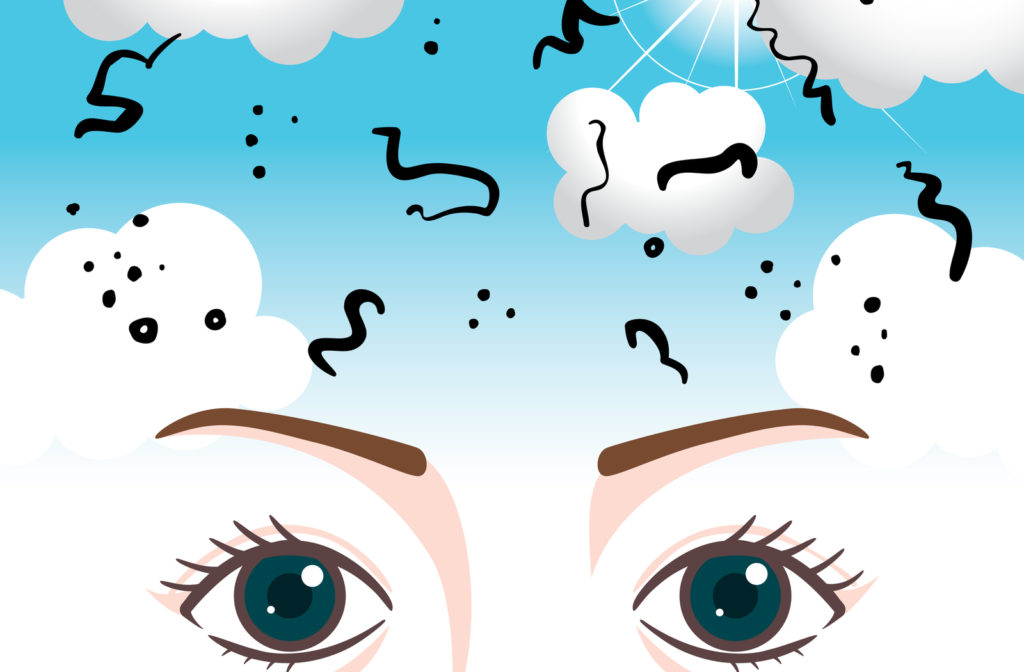Have you ever noticed what seem like specks of dust floating through your field of vision, only to eventually disappear? This is a floater and the vast majority of the time, it’s nothing to worry about.
However, suddenly seeing a lot of new floaters may be an indication that something potentially serious is happening in your eye. Any new visual symptoms should be seen by your optometrist in an eye exam as soon as possible. If your floaters are accompanied by vision loss and/or flashes of light, treat it as an eye care emergency.
Understanding eye floaters can both give you peace of mind that what you’re seeing is normal, and make sure you know what to be aware of when things aren’t so normal.

What Are Eye Floaters?
Floaters, also called spots, may appear in your vision as specks, faint squiggles, cobwebs, or threads. You might especially notice them while looking up at a blue sky, or at another bright surface, like a sheet of paper or whiteboard.
Though they look like particles of dust or fiber floating through the world, they are in fact bits of the vitreous humor inside your eye that are casting a shadow on your retina. (The retina is the part of your eye that receives light and converts it into neural signals so the brain can process what you see. It’s integral to your vision.)
Your eyes are filled with vitreous humor, which is mostly water and has a gel-like consistency. The vitreous fills the majority of the space in your eyeball between the lens at the front of your eye and the retina at the back.
As we age, the vitreous shrinks and becomes more liquid and less gel-like. Small strands of the vitreous can stick together and float past your retina, casting shadows that you see as floaters. These floaters may come and go, or they may be something you’ll just learn to live with.
While this describes normal floaters that are nothing to be worried about, other causes of floaters require your attention.
When Should I Worry About Eye Floaters?
If you notice a lot of new floaters, with or without flashes of light, and with or without loss or changes to your vision, please see your optometrist or head to an emergency room or walk-in clinic immediately. This influx of floaters may be a sign of an eye care emergency.
Retinal Tear & Detached Retina
A retinal tear can happen when the vitreous contracts, pulling the retina away from the wall of the eye. Floaters and flashes of light are the most common symptoms of a retinal tear, but you may also notice changes to your vision, including blurred vision, a shadow over your peripheral vision, or a gray curtain moving over part of your vision.
See your eye doctor immediately if you experience any of those symptoms. In some cases, a retinal tear may resolve on its own, but others will require a simple in-office surgical procedure to fix.
Don’t ignore symptoms of a retinal tear, as it’s possible for it to progress into an even more serious and vision-threatening detached retina. A detached retina must be treated quickly with surgery to reattach it in order to save vision.
Diabetes Complications
People with diabetes are at risk of a condition called diabetic retinopathy, which is damage to the eye’s blood vessels caused by elevated blood sugar levels over time. People with diabetic retinopathy might see floaters due to retinal detachment, or due to bleeding inside the eye that leaks into the vitreous.
Diabetic retinopathy doesn’t have symptoms in its earliest stages, but eventually symptoms can include seeing new floaters, blurred vision, reduced night vision, and damage to central vision. Visit your eye doctor immediately if you notice any of these symptoms.
Regular dilated eye exams are an essential part of your health care when you have diabetes.
Bleeding in the Eye (Vitreous Hemorrhage)
The most common cause of vitreous hemorrhage is diabetic retinopathy, but it may also be caused by an injury to the eye or head, a retinal tear, or bleeding elsewhere in the eye that seeps into the vitreous.
Treatment will depend on what caused the bleeding, but you should book an appointment with your eye doctor immediately if you notice new floaters and a red tint to your vision.
Uveitis
Uveitis is a group of diseases that cause swelling and the destruction of eye tissues, including the vitreous. It’s caused by inflammation and can be related to autoimmune disorders, infections, or bruises to the eye.
Eye Surgery & Medication That Cause Floaters
Some surgeries and medication used to treat eye conditions involve the injection of fluids into the eye. These intravitreal Injections can cause floaters either by having the medication itself or tiny air bubbles that are a byproduct of the injection cast a shadow on the retina.
This type of floater tends to subside once the medication or air bubbles are fully absorbed into the eye. Your eye doctor will let you know about these possible side effects prior to any treatment performed so you know what to expect.

How Can My Eye Doctor Help with Floaters?
When you book an eye exam to have your optometrist investigate new visual symptoms, they will check the health of your eye using a few different methods.
First, they will dilate your eyes with eye drops. The drops widen your pupil and allow a better view of the internal structures of your eye, including the vitreous and retina. Your eye doctor can use an ophthalmoscope and a slit lamp microscope to examine the inside of your eye in just a few minutes.
Your optometrist may also use optical coherence tomography or other forms of noninvasive diagnostic imaging for a high resolution digital view of your retina to assess any damage.
After the exam, your doctor will explain any findings and let you know what they recommend for next steps.
Book Your Next Eye Exam
While it’s important to have any new visual symptoms investigated by your optometrist, you also shouldn’t wait for something to go wrong before seeing your eye doctor. Healthy adults should have a comprehensive eye exam every 2 years, while people with higher risks of eye complications, like those with high refractive errors, a family history of eye disease, or who wear contacts, should see their eye doctor annually.
Make Eyes Now part of your health care team by booking your next appointment soon. We always manage our exam capacity so you can see an optometrist within days because we don’t want you to be left waiting for eye care.



